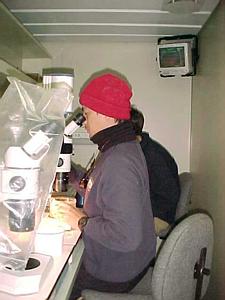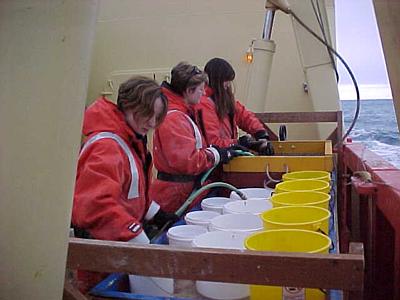
|
|
18 March, 2000
Although today is cloudy it is a relatively calm and pleasant day.
We are spending our time completing the last few samples and data
collections needed at site A and B. We collect one last otter trawl
at site B. Some of the organisms will be frozen for DNA testing back
at the labs. Other organisms are preserved as representative samples
of the macrofauna ( animals which can be seen without a microscope).
Maria Baker and Liz Galley, scientists from the United Kingdom
studying at Southampton are collecting some whole animals from the
trawl and dissecting the gonads (reproductive organs) from other
animals to study reproductive dynamics. Maria is using sea urchins
and Liz is using sea stars for their studies. Both of these animals
are free spawners which means they release their gametes (egg and
sperm) into the water and rely on the water to carry the gametes
together so that fertilization can occur. They are trying to
determine at what density a population has to be in order for
fertilization to be successful. If there are too few animals or they
are spread too far apart then fertilization may not occur. There has
been very little work done in this area.

Dr. Paulo Sumida, A scientist from Brazil uses the ship's microscope to make more detailed observations of the organisms

Scientist, Liz Galley, dissects organisms for gonads

Three scientists from Great Britain, Maria Baker, Liz Galley, Nicola Mitchell sorting the Otter Trawl
Contact the TEA in the field at
.
If you cannot connect through your browser, copy the
TEA's e-mail address in the "To:" line of
your favorite e-mail package.
|
